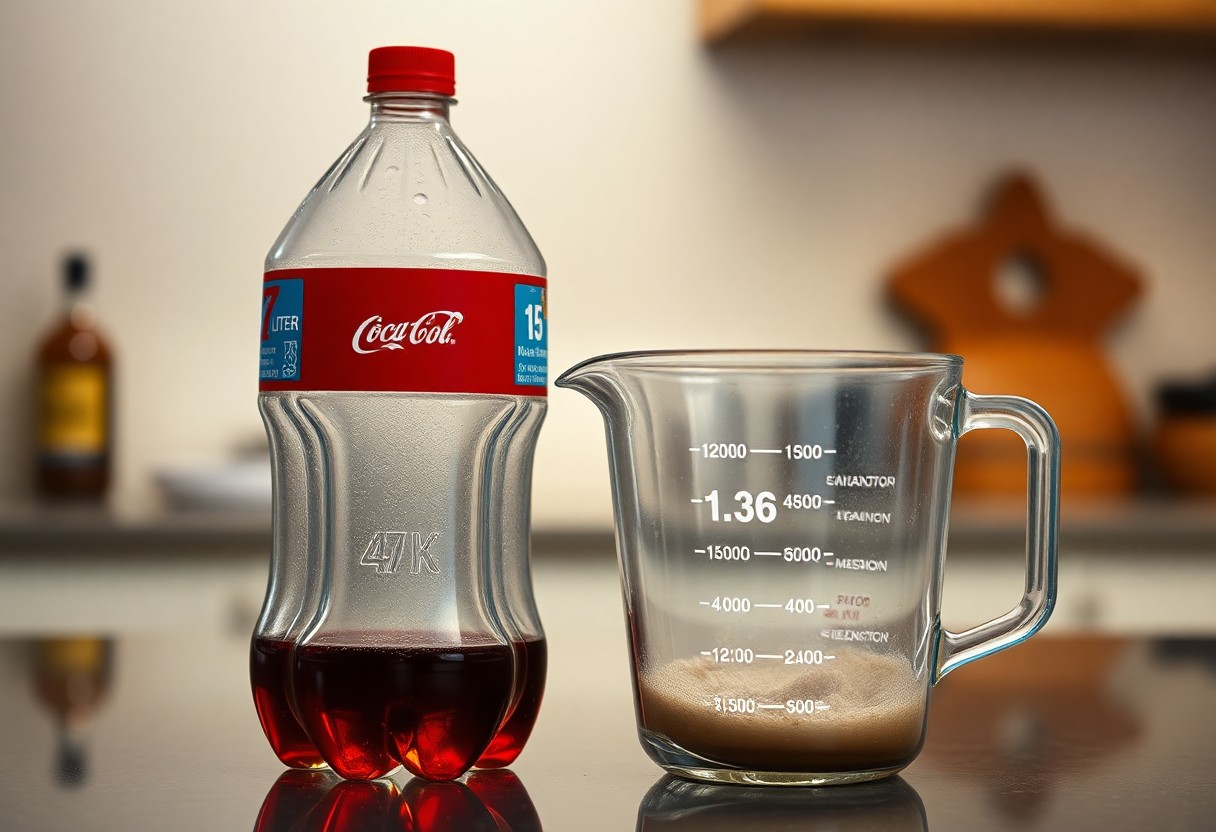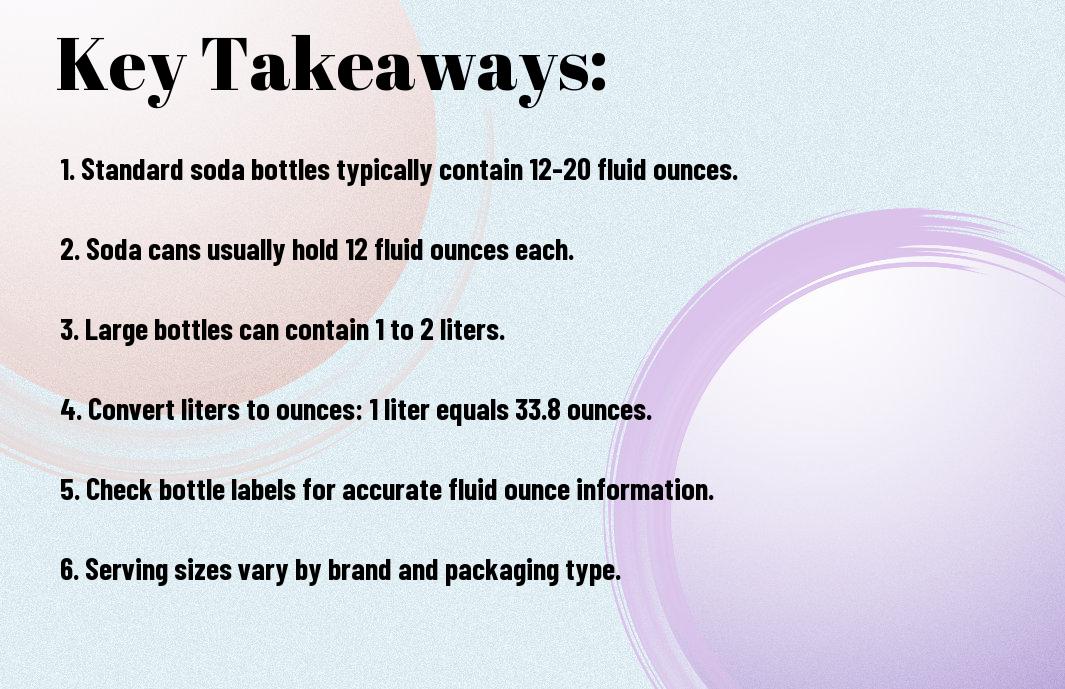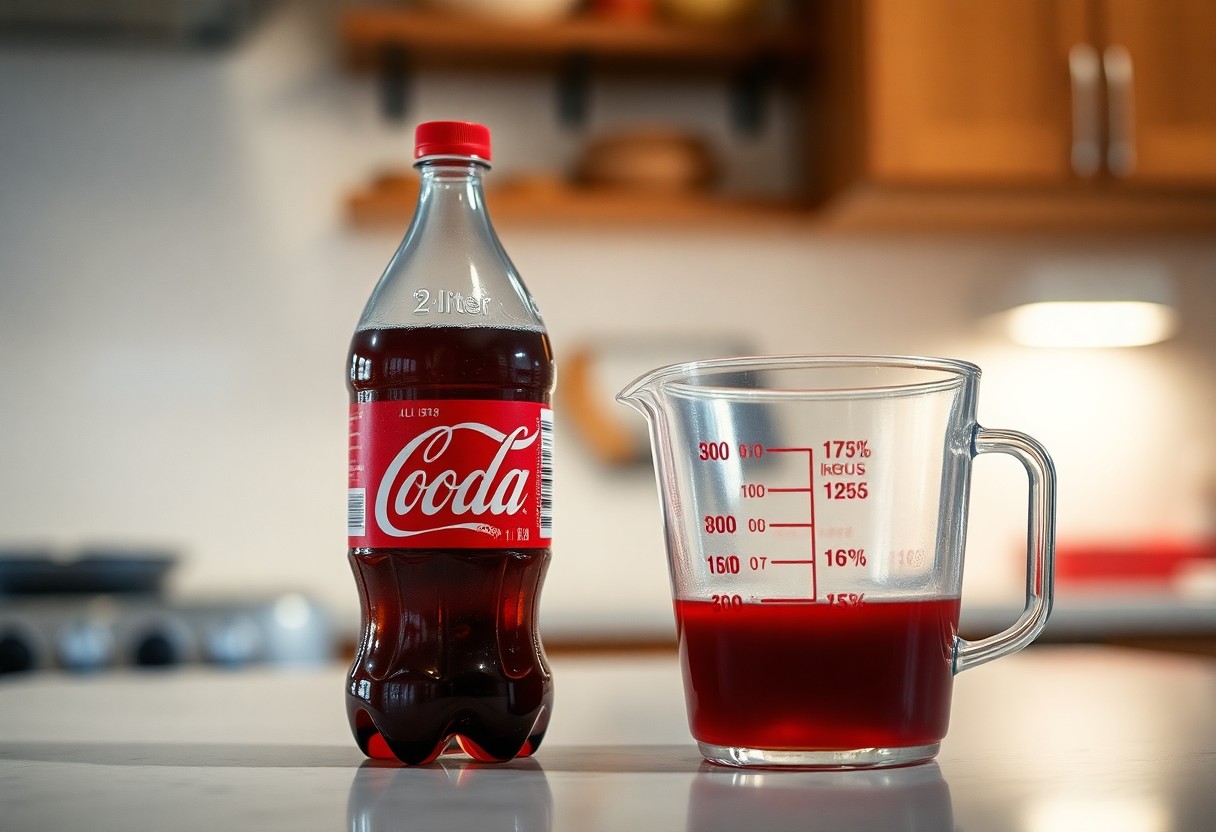With your favorite soda in hand, you might wonder how many fluid ounces are packed in that familiar bottle. Typically, soda is sold in various sizes, including 12-ounce cans, 16.9-ounce bottles, and the ever-popular 2-liter bottles that contain a whopping 67.6 ounces. Understanding these measurements can help you make more informed choices about your beverage consumption. Whether you’re planning a party or simply craving a fizzy drink, knowing the volume can enhance your experience.

Key Takeaways:
- A standard bottle of soda typically contains 20 fluid ounces, though sizes can vary by brand and region.
- Beverage sizes such as 12-ounce cans and 24-ounce bottles are also common, catering to different consumer preferences.
- Always check the nutritional label for precise fluid ounce measurement, as some specialty or larger packaging may differ significantly.
Understanding Fluid Ounces
For anyone navigating the world of liquids, understanding fluid ounces is crucial. Fluid ounces are a standard unit of measurement for volume, primarily used in the United States for beverages. Knowing how many fluid ounces are contained in various containers, like a bottle of soda, is key for everything from portion control to ensuring you stay hydrated.
Definition of Fluid Ounces
On a basic level, a fluid ounce is defined as the volume of a liquid that occupies one ounce under specific temperature and pressure conditions. In the U.S., there are 128 fluid ounces in a gallon and 16 fluid ounces in a pint, providing you a solid framework for understanding liquid measurements.
Importance in Beverage Measurement
With beverage measurement, knowing fluid ounces allows you to gauge serving sizes and manage your consumption effectively. This knowledge is particularly important when ordering drinks, comparing nutritional information, or even figuring out how many calories you’re consuming. Properly understanding fluid ounces can lead to healthier choices.
Another benefit of understanding fluid ounces is the ability to make informed decisions about portion sizes. Whether you’re enjoying a refreshing soda or a sports drink, knowing the exact volume can help you maintain a balanced intake. Additionally, you can easily calculate cost efficiency when comparing products by volume. Being aware of fluid ounces also plays a vital role in educational contexts and helps you communicate more accurately with others when discussing beverage options or nutrition.

Common Sizes of Soda Bottles
Now that you’re interested in soda bottles, it’s important to understand the common sizes available. Soda bottles typically come in a variety of standard sizes, making it convenient for you to choose the right option for your consumption needs. These bottles range from single servings to larger family-sized quantities, catering to different occasions and preferences.
Standard Bottle Sizes
Behind the scenes, soda manufacturers offer several standard bottle sizes to facilitate your enjoyment. The most common options include 12-ounce cans, 20-ounce plastic bottles, and 2-liter glass bottles. Each size delivers a different experience, whether you’re grabbing a quick refreshment or stocking up for a gathering.
Variations in Specialty Bottles
At times, you may encounter specialty bottles that deviate from these standard options. These variations can include collectible glass bottles or eco-friendly packaging designed for specific marketing campaigns. Some limited-edition flavors might even come in uniquely shaped containers, intensifying your excitement in discovering your favorite soda.
Due to the increasing demand for unique experiences, soda companies are experimenting with new and diverse packaging. You may find glass bottles promoting nostalgia or eco-friendly options that appeal to your environmentally conscious side. Additionally, limited editions in special shapes or designs offer you an exciting way to enjoy a classic beverage. These innovations not only enhance your sipping experience but also add a touch of fun and personality to your collection.
Conversion Factors
All liquids are measured in various units, and understanding the conversion factors helps you determine how many fluid ounces are in your favorite soda. When converting between measurement systems, consider these important points:
- 1 US fluid ounce is approximately 29.5735 milliliters
- 1 liter equals approximately 33.814 fluid ounces
- 1 UK fluid ounce is about 28.4131 milliliters
The knowledge of these conversions can greatly enhance your beverage selection and understanding.
Ounces to Milliliters
Factors such as the specific type of measurement system you’re using make converting from ounces to milliliters simple. If you need to transform US fluid ounces to milliliters, just multiply the fluid ounces by 29.5735. This conversion allows you to gauge the liquid content accurately in different contexts like recipes or nutritional information.
Understanding Different Measurement Systems
Before plunging into soda consumption, it is imperative to grasp the concept of different measurement systems. In the beverage industry, you can find both metric and imperial measurements that can create confusion when purchasing or serving drinks. For example, a 12-ounce soda in the US translates to approximately 355 milliliters. In fact, knowing these systems not only aids in choosing your drink accurately, but it can also be important for dietary considerations, especially when keeping track of caloric intake and aiding in meal planning.

Choosing the Right Bottle Size
Despite the numerous soda options available, selecting the right bottle size can make a significant difference in your enjoyment and satisfaction. Consider factors such as your planned consumption frequency, the number of people you’ll be sharing with, and whether you prefer single servings or larger quantities. A more significant bottle can be a practical choice for gatherings, while smaller sizes can be better suited for personal use or on-the-go consumption.
Serving Sizes for Events
With events and parties, you want to ensure there is enough soda for everyone without overspending on excess. Typically, a 2-liter bottle serves about 10 glasses, making it a popular choice for gatherings. However, evaluate the number of guests you have and opt for a mix of bottle sizes to cater to different preferences, ensuring you remain within your budget while providing ample options for your guests.
Personal Consumption Preferences
One person’s taste can significantly impact the bottle size you choose. If you genuinely enjoy sipping soda leisurely, a 20-ounce bottle might be ideal, while a 12-pack or larger bottle suits someone who indulges in several servings at once. Be sure to assess your usual consumption habits and stock up accordingly.
Events naturally draw a crowd, and your soda supply needs to reflect that. Tailor your selections based on how much soda your guests are likely to drink. Consider offering a variety of flavors to appeal to different tastes. This also helps reduce waste by allowing individuals to take what they like, ensuring that your planning accommodates everyone without leaving lingering bottles behind. Ultimately, listening to your guests’ preferences can enhance their experience and keep thirst at bay.
Environmental Considerations
Unlike many other beverages, soda bottles primarily consist of plastic, which has a significant impact on our planet. The production and disposal of these bottles contribute to environmental issues such as pollution and resource depletion. By understanding these factors, you can make more conscious choices that support a healthier planet.
Recycling Plastic Bottles
Plastic bottles from soda are widely recyclable, and when you participate in recycling programs, you help minimize waste. Every bottle you recycle reduces the need for new plastic production, conserving resources and energy. Ensure to rinse and properly sort your bottles to make the recycling process more efficient.
Reducing Carbon Footprint
Behind the convenience of soda consumption lies the environmental impact of transportation and production, both of which significantly contribute to your carbon footprint. The processes involved in making and delivering soda generate greenhouse gas emissions, which you can help reduce through mindful consumption.
The carbon footprint associated with soda includes emissions from manufacturing, transportation, and refrigeration. The beverages you consume may travel long distances, increasing their overall impact on the environment. By opting for locally sourced or less packaged alternatives, you can actively lower these emissions. Additionally, choosing to consume soda in moderation will not only benefit your health but also reduce demand for mass production, ultimately leading to a smaller ecological footprint.
Frequently Asked Questions
After exploring how many fluid ounces are in a bottle of soda, you might still have some lingering questions. Let’s address a few frequently asked questions related to soda sizes and serving recommendations to further your understanding.
How Many Fluid Ounces in a Can?
One standard can of soda contains 12 fluid ounces. This popular size is convenient for single servings and is widely recognized as the typical portion for most soda brands.
What’s the Average Serving Size?
Behind each soda bottle or can, the average serving size typically aligns with about 12 to 20 fluid ounces. These servings vary depending on the type of soda and the specific market preferences.
Even though the average serving size for soda can range from 8 to 20 ounces, you should be mindful of your consumption. Many people might overlook that a standard serving often contains a high level of sugar and calories. It’s imperative to factor in these elements if you want to maintain a healthy diet; moderation is key when enjoying your favorite fizzy drink. Always check the nutritional information to make informed choices that fit your lifestyle.
To wrap up
As a reminder, when it comes to soda bottles, you typically find either 12-ounce, 16-ounce, or 20-ounce options available. Most standard cans contain 12 fluid ounces, while single-serve plastic bottles commonly hold 20 fluid ounces. If you’re purchasing larger quantities, look for 2-liter bottles, which contain approximately 67.6 fluid ounces. Understanding these measurements can help you choose the right product for your needs, ensuring you have the right amount of refreshment on hand for any occasion.
FAQ
Q: How many fluid ounces are typically in a standard bottle of soda?
A: A standard bottle of soda commonly contains 16.9 fluid ounces, which is equivalent to 500 milliliters. This size is widely available in convenience stores and supermarkets, making it a popular choice for consumers.
Q: Are there different sizes of soda bottles available?
A: Yes, soda bottles come in various sizes. Besides the standard 16.9 fluid ounce bottle, you can find larger bottles such as 1-liter bottles (approximately 33.8 fluid ounces) and 2-liter bottles (about 67.6 fluid ounces). Some smaller options include 12-ounce cans and 8-ounce bottles, catering to different preferences and usage occasions.
Q: How many fluid ounces are in a 2-liter bottle of soda?
A: A 2-liter bottle of soda contains approximately 67.6 fluid ounces. This size is popular for gatherings and parties, as it provides enough beverage for several servings.
Q: Is the fluid ounce measurement the same for all types of beverages, including soda?
A: Yes, fluid ounces are a standard unit of measurement for liquids in the United States, regardless of the type of beverage. Therefore, a fluid ounce of soda is measured the same way as a fluid ounce of water, juice, or any other liquid.
Q: How does the size of a soda bottle impact nutritional information?
A: The size of a soda bottle influences the nutritional information, such as calories and sugar content. For example, a standard 16.9 fluid ounce bottle may contain around 200 calories and 50 grams of sugar, while a 2-liter bottle contains significantly more. It’s important to check the label for specific serving sizes and to understand how much of the nutritional content you will consume based on the size of the bottle.
